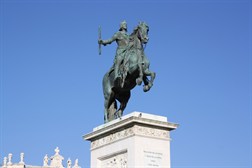Philip IV and the Plaza de Oriente in Madrid
 Succeeding his father at the age of just 16, Philip IV reigned over Spain and the Spanish dominions in Europe and America for 44 years (1621-1665). During this period, Spain underwent a strong crisis linked to harsh and unrealistic military commitments, which led to frequent bankruptcies. Soon the government of Gaspar de Guzmán, Count-Duke of Olivares (1587-1645), the powerful favourite of Philip IV, came under attack, a government which he had exercised, in the king’s name, for over twenty years. Olivares tried in vain to re-establish Spanish hegemony in Europe and to remedy the financial crisis of the monarchy: the expiration of the Twelve years’ truce (1609-1621), he resumed the war against the United Provinces; he worked alongside the Austrian Habsburgs in the Thirty Years’ War; at the same time, he sought to restore the finances of the state, redistributing the tax burden among the different kingdoms. For this purpose he promoted a project called the “Union of the armies” (1624), which provided for the distribution of military spending, previously supported only by Castile, among all the territories of the Crown. This initiative led to a wave of revolutions, during which major kingdoms and territories of the Monarchy violently claimed their ancient freedom and autonomy: Portugal and Catalonia rebelled in 1640, Palermo and Naples (the so-called Masaniello revolt) in 1647-1648. Even after Olivares’ dismissal in 1643, the military decline of the monarchy did not stop. Permanently losing Portugal, it had to give up all claim of sovereignty over the United Provinces, while the long conflict with France was resolved after the Peace of the Pyrenees (1659), with the end of Spanish dominance in Europe.
Succeeding his father at the age of just 16, Philip IV reigned over Spain and the Spanish dominions in Europe and America for 44 years (1621-1665). During this period, Spain underwent a strong crisis linked to harsh and unrealistic military commitments, which led to frequent bankruptcies. Soon the government of Gaspar de Guzmán, Count-Duke of Olivares (1587-1645), the powerful favourite of Philip IV, came under attack, a government which he had exercised, in the king’s name, for over twenty years. Olivares tried in vain to re-establish Spanish hegemony in Europe and to remedy the financial crisis of the monarchy: the expiration of the Twelve years’ truce (1609-1621), he resumed the war against the United Provinces; he worked alongside the Austrian Habsburgs in the Thirty Years’ War; at the same time, he sought to restore the finances of the state, redistributing the tax burden among the different kingdoms. For this purpose he promoted a project called the “Union of the armies” (1624), which provided for the distribution of military spending, previously supported only by Castile, among all the territories of the Crown. This initiative led to a wave of revolutions, during which major kingdoms and territories of the Monarchy violently claimed their ancient freedom and autonomy: Portugal and Catalonia rebelled in 1640, Palermo and Naples (the so-called Masaniello revolt) in 1647-1648. Even after Olivares’ dismissal in 1643, the military decline of the monarchy did not stop. Permanently losing Portugal, it had to give up all claim of sovereignty over the United Provinces, while the long conflict with France was resolved after the Peace of the Pyrenees (1659), with the end of Spanish dominance in Europe.
Even Philip IV, like his father before him, wanted to be depicted with an equestrian statue that symbolized his power. This statue, located at the center of the Plaza de Oriente at the behest of Isabel II, was built, like that of Philip III, by the sculptor Pietro TaccaPietro Tacca (1577-1640) was one of the main representatives of the Baroque style in Italy. A pupil of Giambologna, he is best known as the author of the equestrian statues of Philip III and Philip IV of Spain. He made an equestrian monument for the king of France, Henry IV, which, however, was destroyed during the French Revolution. Other valuable works of his are the Four Moors chained to the base of the monument to Ferdinand I de’ Medici at Livorno and the two bronze fountains of Piazza Santissima Annunziata in Florence. at the request of the Count-Duke of Olivares. The work is particularly important for its technical characteristics, being the first horse in the history of sculpture to support itself solely on its hind legs and tail. Velázquez also contributed to its realization, providing two sketches to Tacca, in addition to Juan Martínez MontañésJuan Martínez Montañés (1568-1649) was a sculptor, born in Alcalá la Real (Jaén). He trained in Granada with Pablo de Rojas and completed his education in Seville, where he would remain for the rest of his life, becoming the highest representative of the Sevillian school of sculpture of his generation. Particularly skilled in woodworking, the works of Martínez Montañés are almost exclusively of a religious nature. There is a portrait of him painted by Velázquez and now preserved in the Museo del Prado., the author of the bust of the monarch, and Galileo Galilei, who gave his advice to ensure the stability of the statue.
